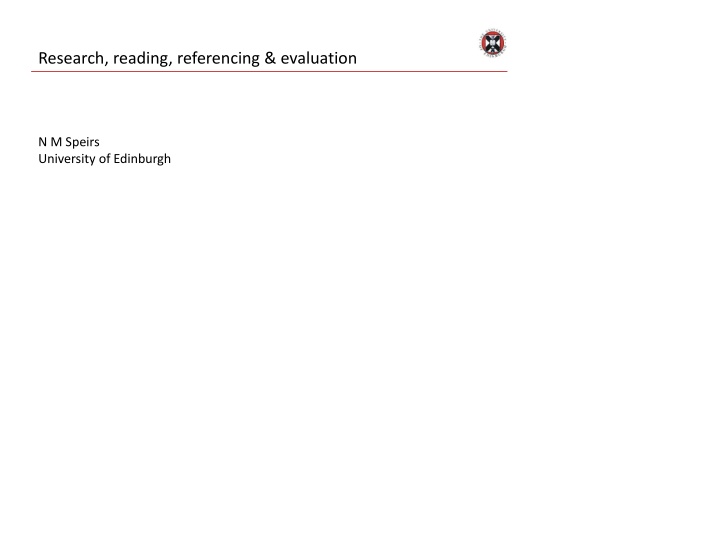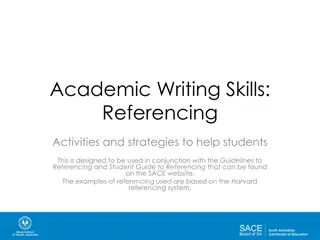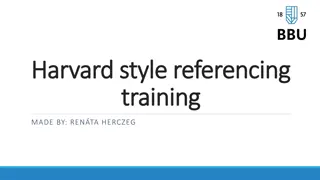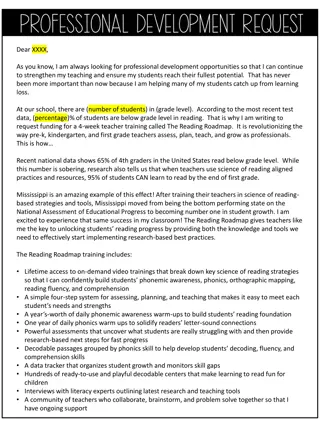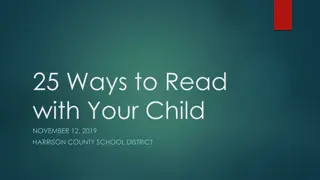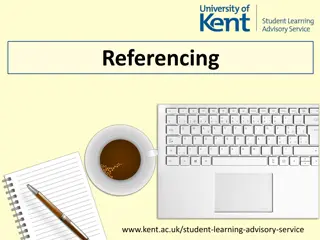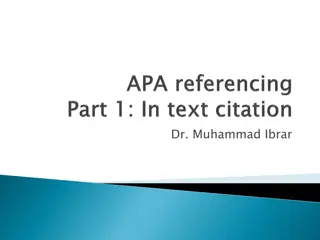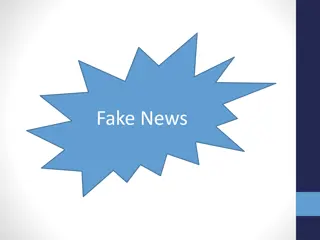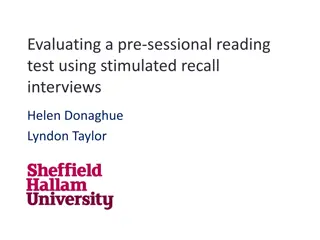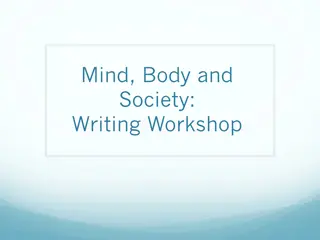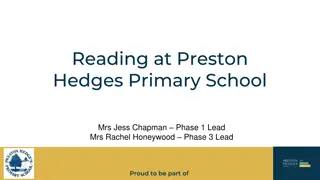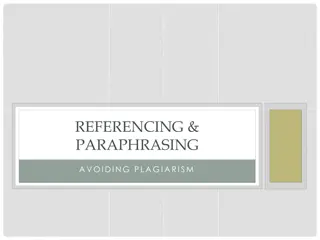Enhancing Research Skills: Reading, Referencing, and Evaluation
Explore the importance of research, reading, referencing, and evaluation in academic learning, alongside tips on sourcing reliable information, analyzing content, and using proper referencing styles.
Uploaded on Oct 07, 2024 | 0 Views
Download Presentation

Please find below an Image/Link to download the presentation.
The content on the website is provided AS IS for your information and personal use only. It may not be sold, licensed, or shared on other websites without obtaining consent from the author.If you encounter any issues during the download, it is possible that the publisher has removed the file from their server.
You are allowed to download the files provided on this website for personal or commercial use, subject to the condition that they are used lawfully. All files are the property of their respective owners.
The content on the website is provided AS IS for your information and personal use only. It may not be sold, licensed, or shared on other websites without obtaining consent from the author.
E N D
Presentation Transcript
Research, reading, referencing & evaluation N M Speirs University of Edinburgh
Research, reading, referencing & evaluation The relevance of the lecture? And what about the tutorial & laboratory? How does this all fit into my learning and ability to deal with exams? Assessment literacy?
Research, reading, referencing & evaluation What should you be reading? Where would you find these sources? How would you evaluate the reliability of these sources?
Research, reading, referencing & evaluation There are a number of different sources that you can use; Text book Journal article Report Web site Your university library will be the place to find these sources. Sometimes you wont even need to go into the library, it can be done online e.g. finding & printing a journal article. What ever source you use, it is important that you are able to gauge its reliability.
Research, reading, referencing & evaluation What s your analysis of the content? Read the preface (book) or abstract (article) to determine the author's intentions. Is this source too elementary, too technical, too advanced, or just right for your needs Is the information fact, opinion, or propaganda Does the information appear to be well-researched & evidenced Does the work update other sources, substantiate other materials you have read, or add new information
Research, reading, referencing & evaluation References have two purposes: (1) to provide the source of information you use (2) to enable the reader to find it. There are a number of different styles that can be employed. You need to check that you are using the correct style.
Research, reading, referencing & evaluation What does all this tell us? Campbell, N. A., Reece, J. B., Urry, L. A., Cain, M. L., Wasserman, S.A., Minorsky, P. V. and Jackson, R. B. (2008) Biology (8th edition). Published by Pearson Education. ISBN-13: 978-0321536167. Chapter 6 (A Tour of the Cell) Hillis, D. M., Sadava, D., Heller, H. C. and Price, M. V. (2012) Principles of Life. Published by Sinauer Associates. ISBN-13:978-1429286572. Pauling, L., and Corey, R. B., J. Am. Chem. Soc., 72, 5349 (1950). Astbury, W. T., and Bell, F. O., Nature, 147, 696 (1941). Jones, A.C., Speirs, N.M. et al, J. Phys. Chem. A, 2002, 106 (44), pp 10725 10732.
Research, reading, referencing & evaluation Where do the references appear? The dimerization of phthalocyanines (and the closely related porphyrins) and its effects on the UV Vis absorption spectrum are well documented in the literature (1 10). Dimerization results in a significant blueshift in the Q band region together with some band broadening. That is, the absorption band of the dimer species lies at higher energy than does that of the monomer. This can be explained in terms of exciton coupling between the two monomer chromophores (4,5,11). Leznoff, C. C., A. B. P. Lever 1989 Phthalocyanines Properties and Applications VCH Publishers, New York Gouterman, M. 1978 Optical spectra and electronic structure of porphyrins and related rings In The Porphyrins, Vol. III (Edited by D.Dolphin), pp. 1 156. Academic Press, San Diego Sheppard, S. E., A. L. Geddes (1944) Effects of solvents on the absorption spectra of dyes. IV. Water as solvent: a common pattern. J. Am. Chem. Soc, 66, 1995 2002.
Research, reading, referencing & evaluation Where do the references appear? Research pertaining to the interaction between carbon nanotubes and conjugated organic molecules is attracting growing interest as a new topic of fundamental research with numerous potential applications ranging from sensing1 to photovoltaics.2 Combining the remarkable electrical, thermal, and mechanical properties of carbon nanotubes3 with the optoelectronic properties of conjugated organic compounds is also a promising path to realizing hybrid composite materials for utilization in emerging disruptive technologies such as nanoelectronics.2,4-6 Increasingly, materials systems exhibiting spontaneous nanostructuring upon processing from solution have also come to the fore as an economical path to realizing optimized device structures.7,8
Research, reading, referencing & evaluation Now you try .. Author; N. Tang Journal; Atmos. Environ. Year; 1980 Title; On the equilibrium partial pressures of nitric acid and ammonia in the atmosphere. Volume/page; 14, 819-834 Author; William R. Harvey, Signe Nedergaard Journal; Proc. Natl. Acad. Sci. U.S.A. Year; 1964 Title; Sodium-independent active transport of potassium in the isolated midgut of the Cecropia silkworm. Volume/page; 51, 731-735 Author; Hassan, B.; Li, H.; McKeown, N. B. Journal; J. Mater. Chem. Year; 2000 Title; Volume/page; 10, 39 45.
Research, reading, referencing & evaluation Now you try .. N. Tang, On the equilibrium partial pressures of nitric acid and ammonia in the atmosphere. Atmos. Environ.14, 819-834 (1980). William R. Harvey, Signe Nedergaard, Sodium-independent active transport of potassium in the isolated midgut of the Cecropia silkworm. Proc. Natl. Acad. Sci. U.S.A.51, 731-735 (1964). Hassan, B.; Li, H.; McKeown, N. B. J. Mater. Chem. 2000, 10, 39 45.
Research, reading, referencing & evaluation TheRoyal Society of Chemistry referencing style; Journal articles should be cited in the form: A. Name, B. Name and C. Name, Journal Title, year, volume, page. For example; T. J. Hebden, R. R. Schrock, M. K. Takase and P. M ller, Chem. Commun., 2012, 48, 1851 1853. Books should be cited in the form: A. Name, B. Name and C. Name, Book Title, Publisher, Publisher Location, year. For example; S T Beckett, Science of Chocolate, Royal Society of Chemistry, Cambridge, 2000.
Research, reading, referencing & evaluation So, what research & enquiry related skills have I developed? identify (e.g. counter examples) define analyse problems identify or create solutions synthesise evaluate critique / critical judgment / critically assess interpret creating new understanding thinking creatively or imaginatively formulate key questions rational enquiry search for, evaluate and use information
